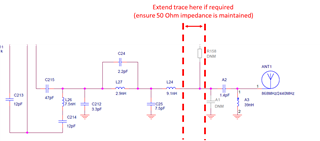Tool/software:
If we have a rectangular, listening and retransmitting PCB with receiving antenna connector along one short end and a transmitting chip antenna at the other, where should the CC1190 optimally sit along the length of PCB? Chip antenna manufacturer wants a short transmission line between PA and antenna, while we're concerned of the receiving side being more susceptible to noise and interference if there's a long trace on the reception side.



